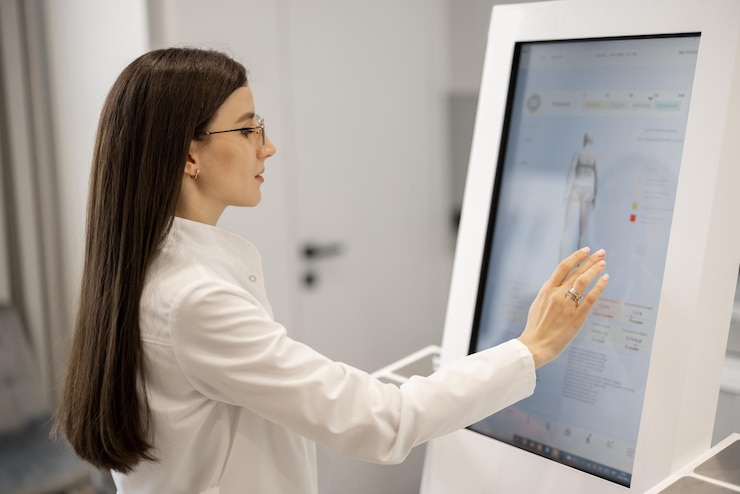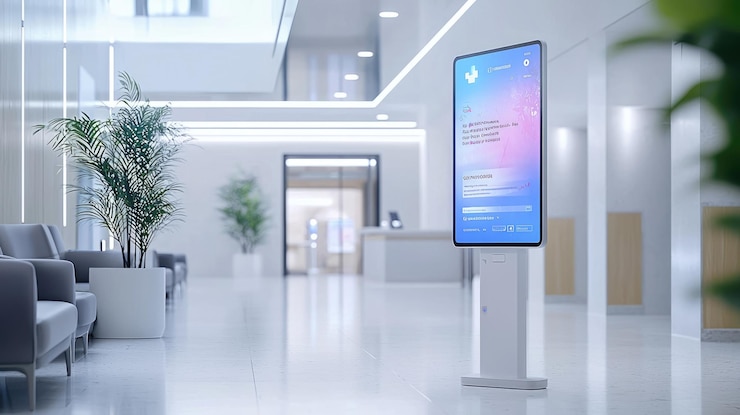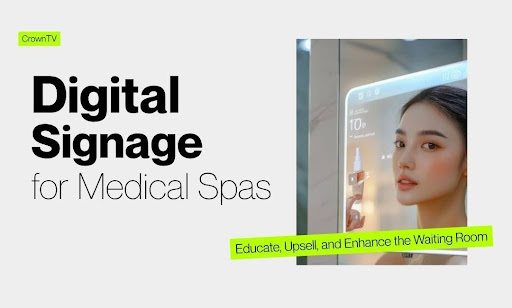Digital signage isn’t just for restaurants and retail anymore. Medical spas are waking up to something smarter—screens that sell, inform, and set the tone before the client even hits the chair.
Here’s the part most places miss: your waiting room is your first impression. And if that impression is silence, outdated brochures, or a looped slideshow from 2012, you’re losing ground. You could be educating, upselling, and calming nerves—all at once—with a screen that does the heavy lifting.
If you’re tired of blank walls and underperforming front desks, you’re in the right place.
This article will show you how to:
- Turn idle time into educated time using visual content
- Upsell services without sounding like a sales pitch
- Create a calm, elevated atmosphere that sets expectations
- Use CrownTV’s tools to pull it all off—without lifting a finger
You’re already investing in interiors, staff, and tools. Why stop short at your screens? Let’s fix that.
Make Waiting Rooms Work Harder With Educational Content
Every minute your client waits is an opportunity—if you use it right. Digital signage flips passive waiting into productive engagement. No one wants to stare at their phone or flip through outdated magazines. What they will do is watch a sleek screen that shows them something relevant, helpful, and maybe even a little surprising.
You’re not selling. You’re informing. And in the process, you’re shaping how they view your services.
Here’s what smart medical spas display on their screens to keep people engaged and informed:
- Pre-treatment prep and aftercare instructions
- Explanations of procedures using simple visuals or animations
- Spotlight segments on ingredients or technology used in services
- Frequently asked questions with concise, visual answers
- Lifestyle or skincare tips aligned with seasonal needs
This kind of content builds trust. It shows you’re transparent. It sets the tone before the consultation even begins.
Use visual motion to hold attention, but don’t overload the screen. Each message should be clean, timed right, and easy to absorb at a glance. Educating through digital signage doesn’t require volume—it requires precision. Get the content right, and the screen earns its spot.
Subtle Ways to Boost Add-On Sales Without Saying a Word
Upselling doesn’t need a script. It needs the right screen at the right moment, with content that speaks for itself.
Digital signage in a medical spa waiting room works best when it shifts attention toward what’s possible. Clients aren’t thinking about upgrades while checking in. But once seated, relaxed, and watching a clean loop of engaging visuals? You’ve got their focus.
Here’s where the upsell starts working.
- Feature pairings. Show complementary treatments that go hand-in-hand, like LED facials with chemical peels, or dermaplaning before microneedling. Use visuals to demonstrate the flow and value without needing a word from your staff.
- Before-and-after reels. Let real, unedited results speak for your services. When shown with brief service explanations, they don’t feel pushy—they feel credible.
- Highlight add-ons in real service footage. A short clip of a facial ending with a cryo boost treatment? That plants a seed. Bonus: clients often ask about what they’ve seen, not what they’ve read.
- Time-limited promos or bundles. Use subtle transitions and minimal text to promote upgrades. Keep it on brand, not in-your-face.
Effective upselling with digital signage feels natural. No pressure. No cluttered messages. Just curated content that nudges interest toward higher value.
Use Visuals to Set the Mood and Signal Quality

In a medical spa, perception is treatment. Before any hands-on care begins, clients subconsciously assess whether they’re in capable, professional hands—often within seconds of sitting down.
Digital signage plays a critical role here, but it can’t look like a screen trying to sell something. It has to blend into the space while reinforcing the spa’s credibility, hygiene standards, and quality of care.
Environmental Visual Design in Medical Spas
Visual content should align with the principles of biophilic and sensory design—methods that reduce cortisol levels and establish emotional safety through gentle stimuli. This includes:
- Low-saturation palettes (e.g., eucalyptus green, blush beige, slate gray)
- Slow motion loops under 24fps to reduce cognitive fatigue
- 1-2 minute content cycles to avoid visual overstimulation
- White space-rich layouts with generous visual breathing room
- Smooth ambient transitions with cross-dissolves, not cuts
Digital displays should be placed within the patient sightline zone (between 4ft–6ft above floor level) and avoid direct competition with reflective surfaces like mirrors or glossed glass. Keep brightness calibrated between 250–350 nits for indoor use to prevent harsh contrast in soft-lit rooms.
Content Strategy That Reinforces Trust
Instead of passive entertainment, use screen time to subtly anchor the brand’s professional promise. Highly effective content in waiting zones includes:
- Step-by-step visualizations of key treatments, stripped of clinical jargon, to reduce uncertainty
- Display certifications and accreditations in a carousel format, backed by organization logos
- Client satisfaction scores or anonymized feedback in soft fade-in text blocks
- Treatment timelines and healing phases, visualized through gentle animated infographics
- Seasonal skin care guidance from in-house practitioners with muted lower-third identifiers
Each of these pieces delivers value while contributing to the overall tone—clean, elevated, and grounded in medical-grade service.
Choose the Right Screen for the Right Space
Not all displays are built to perform under the same conditions. A screen that works beautifully in a dim treatment room may completely fail in a windowed lobby under natural light. Choosing between indoor and window-facing displays isn’t a design preference—it’s a technical decision that impacts visibility, brand perception, and system performance.
Indoor Displays: Focused, Controlled, and Configurable
Indoor screens work best in controlled lighting environments like treatment rooms, corridors, and interior waiting areas. In these spaces, clarity, resolution, and screen size matter more than brightness.
Here’s what to consider:
- Brightness levels between 250–400 nits are typically sufficient for indirect lighting
- Portrait or landscape orientation should be based on content type and available wall real estate
- Eye-level placement ensures readability without requiring clients to adjust posture or shift focus
- Anti-glare coatings or matte finishes can help reduce reflection from overhead fixtures
- Audio output is generally unnecessary and should be avoided unless used in private consultation areas
Indoor signage excels at educational content, promotional messages, or treatment prep visuals where clients already feel settled and receptive. The goal is to reinforce comfort and professionalism without visual noise.
Window-Facing Displays: Built for Visibility and Impact
Window screens face an entirely different challenge—ambient light. Direct sun exposure can wash out low-brightness displays within minutes, making content unreadable and damaging the screen’s lifespan. That’s where high-brightness commercial displays are required.
Best practices for window signage:
- Use screens rated for 2,500–4,000 nits brightness to overcome glare and sunlight
- Install with UV-filtering window film to reduce heat exposure and extend display life
- Always rear-mount or recess displays where possible to protect against tampering or theft
- Avoid excessive animation; high-motion visuals in bright environments increase power consumption and reduce screen clarity
- Content should be bold, minimal, and high contrast—think headline, subtext, one image
Window signage should attract, not educate. It’s best used to promote seasonal campaigns, membership offers, or treatment categories that invite walk-in inquiries.
Placement Strategy and Operational Impact
Each display type requires different power, mounting, and networking considerations. Mixing indoor and window signage introduces complexity that can’t be solved by plug-and-play devices. Cabling, content zoning, environmental protection, and brightness calibration all require expert planning.
Medical spas that get this right see measurable returns. One multi-location brand reported a 22% increase in new client walk-ins after deploying high-brightness window signage across its main entrances—proof that visibility directly supports acquisition.
The right screen in the wrong place underperforms. The right screen in the right place transforms waiting time into business growth.
Why Screens Alone Won’t Cut It Without Professional Support

Mounting a display is easy. Making that display work for your business is another story entirely. Educating, cross-selling, and creating a refined experience in a medical spa healthcare setting isn’t something you can delegate to a smart TV and hope for the best.
You need control. You need consistency. You need a team that knows how to do this right, from installation to execution. That’s where CrownTV becomes the obvious choice.
One Platform to Manage It All
Managing screens in one location is simple—until it’s not. Add multiple treatment rooms, waiting room furniture, or satellite locations, and suddenly you’re juggling USB drives, outdated software, and multiple remote controls. That’s not scalable. That’s not sustainable.
CrownTV’s digital signage software is built for centralized control. It gives medical spas a unified, web-based dashboard to control every display, playlist, and schedule, regardless of how many locations or screens are involved.
This platform allows administrators to:
- Schedule content based on dayparting, appointment types, or spa zones
- Instantly update messaging across multiple clinics from a single login
- Monitor device health and playback status in real time
- Set user permissions by role to protect brand consistency
- Automate loops of educational, promotional, and compliance content
With well-executed digital signage, perceived wait times shrink without clients even realizing it. A clean display loop filled with informative, branded content distracts from actual wait duration and helps build a more welcoming waiting room.
For multi-location medical spas, this eliminates the risk of brand drift, content delay, or unsynchronized messaging. Everything updates remotely. Everything remains aligned.
Media Hardware That Never Misses
A screen is only as strong as the player behind it. Consumer-grade streaming sticks aren’t built for medical environments—or for professional uptime requirements.
The CrownTV’s media player is purpose-built for 24/7 commercial performance. It runs on a solid-state architecture with zero moving parts, which reduces failure rates in high-usage environments. It also includes active health monitoring, remote reboot capability, and thermal management to handle confined spaces behind front desks or treatment rooms.
Dynamic displays supported by this hardware can present real-time updates, personalized greetings, or even weather-based skin care promotions, without manual input from staff. Operational efficiency improves when each screen is part of a synchronized system that runs itself. There’s no lag, no unexpected blackouts, and no reboots during business hours.
Technical specs include:
- Commercial-grade SoC (system on chip) for faster rendering
- 4K UHD output with dynamic resolution scaling for visual consistency
- Network connectivity via Wi-Fi or wired Ethernet with fallback protocols
- Local storage caching in case of internet loss—ensuring uninterrupted playback
- Seamless firmware updates without disrupting scheduled content
This isn’t a modified consumer product. It’s signage-grade hardware—tested across thousands of screens in environments where reliability matters more than anything.
Custom Integrations That Fit Your Spa
No two spas operate the same way. Some prioritize membership renewals. Others focus on cross-selling skincare or treatment bundles. Some want seasonal rotation across locations. That’s where CrownTV’s apps and integrations library becomes a strategic asset.
Instead of static playlists or generic widgets, our system allows for direct API integrations and plug-and-play apps that support:
- Live queue systems that display estimated wait times based on backend scheduling
- Client review feeds from Google or Yelp, refreshed in real time
- On-screen retail promotions linked to your POS inventory levels
- Loyalty program updates pushed from your CRM
- Feedback collection post-service using touchscreen or QR-initiated surveys
When you display educational content that matches your spa’s offerings and treatment calendar, clients engage without pressure. They learn. They ask questions. They make better-informed decisions. And that leads directly to better patient satisfaction and higher ticket values, with less effort from staff.
Full Deployment, No Stress
The most overlooked—and most critical—phase of digital signage is the physical deployment. Misplaced screens, poor cabling, mismatched hardware, or skipped calibration can derail even the best content strategy. CrownTV handles every detail through its turnkey installation service, trusted by national and boutique brands alike.
Here’s what professional deployment really includes:
- On-site surveys to assess lighting conditions, wall types, foot traffic paths, and sightlines
- Display selection based on environment—waiting areas, bright lobbies, or treatment corridors
- Hardware coordination—brackets, cabling, networking, and power sources scoped and sourced in advance
- Professional installation by certified technicians with spa-specific considerations (sound, brightness, interference)
- Post-install validation to test content sync, screen heat output, media player performance, and audio bleed
- Ongoing support with remote diagnostics, screen status alerts, and content troubleshooting
When your digital signage is purpose-built and professionally deployed, it leaves a positive impression before a single word is spoken. And that impression carries into treatment satisfaction, online reviews, and client loyalty.
Digital Signage for Medical Spas Made Simple and Strategic
Put the right content on the right screen, and your waiting room stops being dead space—it becomes an extension of your service.
Clients feel more confident because they understand what to expect. Upsells happen without pushback because interest builds before the consultation. Your team answers fewer repetitive questions. And the entire spa experience feels more thoughtful, structured, and aligned.
That’s the outcome of using digital signage as a strategy, not a screen with a loop. It replaces guesswork with control. It supports your staff instead of distracting them. It meets your brand where it lives: calm, clinical, and quietly persuasive.Medical spas that use CrownTV don’t need to build this system from scratch. The software, the hardware, the integrations, and the white-glove setup are already working in hundreds of locations. If you’re ready to move past generic displays and toward something that actually supports growth, CrownTV is built for that.

